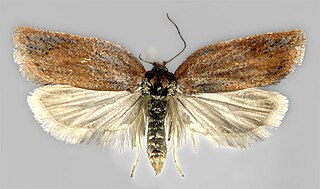Coleostoma is a genus of moths in the family Gelechiidae. It contains the species Coleostoma entryphopa, which is found in Pará, Brazil.

Notocelia rosaecolana is a moth of the family Tortricidae. It is found in the Palearctic realm, where it has been recorded from China, Mongolia, Korea, Japan, Iran, Central Asia, Russia and Europe.

Ypsolopha scabrella, the wainscot hooktip or wainscot smudge, is a moth of the family Ypsolophidae. The species was first described by Carl Linnaeus in 1761. It is found in Europe, China, Russia, Asia Minor and mideast Asia.

Acleris rufana is a moth of the family Tortricidae. It is found from northern, central and south-western Europe through southern Siberia to the Russian Far East and Japan.

Nycteola revayana, the oak nycteoline, is a moth of the family Nolidae. The species was first described by Giovanni Antonio Scopoli in 1772. It is found from Europe and east across the Palearctic to Japan and India.

Sabatinca calliarcha is a species of moth belonging to the family Micropterigidae. It was described by Edward Meyrick in 1912. It is endemic to New Zealand. It is found in two separate areas of New Zealand - the first in the northern parts of the North Island including Great Barrier Island and the second population can be found from the top of the South Island down to Southland. The adults of the species are on the wing from the end of September until the middle of January. The species prefers to inhabit damp forests and larvae likely feed on leafy liverwort species. Adult moths likely feed on the spores of ferns or the pollen of sedge grasses.

Ancylis mitterbacheriana is a species of moth of the family Tortricidae. It is found in most of Europe, except the Iberian Peninsula, most of the Balkan Peninsula and Ukraine.
Helcystogramma heterostigma is a moth in the family Gelechiidae. It was described by Alexey Diakonoff in 1967. It is known from the Philippines (Luzon).
Seticosta chlorothicta is a species of moth of the family Tortricidae. It is found in Ecuador in Napo, Tungurahua, Morona-Santiago and Loja provinces.

Gelophaula trisulca is a species of moth of the family Tortricidae. It is found in New Zealand.

Pyrgotis plinthoglypta is a species of moth of the family Tortricidae. It is endemic to New Zealand and is found throughout the whole country. The preferred habitat of this species is native forest. The larvae of this species feeds on rimu leaves from under a silken web. It pupates in loose cocoons amongst rimu foliage. Adults are on the wing from October to May and are night flying. They are attracted to light and can be collected by beating their host tree. The adult insect resembles a small dried fragment of rimu foliage when at rest.
Sirindhornia curvicosta is a species of moth of the family Tortricidae. It is found in Thailand. The habitat consist of secondary forests.
Spatalistis translineata is a species of moth of the family Tortricidae. It is found on Java.
Dichomeris argentaria is a species of moth in the family Gelechiidae. It was described by Edward Meyrick in 1913. It is found in Mpumalanga, South Africa.
Charistica ioploca is a moth in the family Gelechiidae. It was described by Edward Meyrick in 1922. It is found in Amazonas, Brazil.
Hapalonoma argyracta is a moth in the family Gelechiidae. It was described by Edward Meyrick in 1914. It is found in Guyana.
Compsolechia mniocosma is a moth of the family Gelechiidae. It was described by Edward Meyrick in 1922. It is found in Peru.
Idiophantis carpotoma is a moth of the family Gelechiidae. It was described by Edward Meyrick in 1916. It is found in southern India.
Paraspastis circographa is a moth of the family Depressariidae and the only species in the genus Paraspastis. It is found in Guyana.
Aeolanthes dicraea is a moth in the family Depressariidae. It was described by Edward Meyrick in 1908. It is found in India (Assam).







